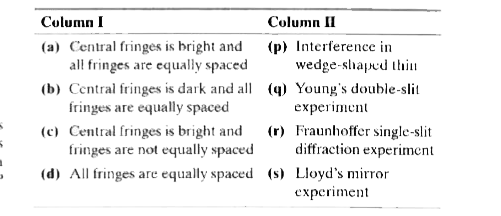Match the increasing orders given in column I with the property given in column II
Column-IColumn-II(A)Na+<F−<O2−<N3−(p)Electronegativity(B)Li+<Na+<K+<Rb+<Cs+(q)Nuclear charge(C)OltSltFltCl(r)Size(D)Cl−<K+<Ca2+<Sc2+(s)Electron affinity(t)Ionisation energy
The correct Answer is:A-r ; B-q,r ; C-s ; D-p,q,s,t
(A)For isoelectronic species, the ionic size decrease with increase in nuclear charge
(B)Number of atomic shells increases, ionic size increases.
(C )Correct order,as Cl has less inter electronic repulsions than F due to bigger size of 3p-subshell
(D)Oxidation state increases, the electronegativity increases.For isoelectronic species ionisation energy and electron affinity increases with increasing nuclear charge.
Topper's Solved these Questions
Similar Questions
A red solid is insoluble in water.However it becomes soluble if some KI is added to water.Heating the red solid in a test tube results in liberation of some violet coloured fumes and droplets of a metal appear on the cooler parts of the test tube.The red solid is :
View SolutionSodium (Na=23) crystallizes in bcc arrangement with the interfacial separation between the atoms at the edge 53.6±. The density of sodium crystal is :
View Solution{:(,"Column I",,"Column II",),((A),Li^(+) (g) lt Be^(+2) (g),(P),1^(st) "ionisation energy",),((B),Li^(+) (g) lt Be^(+2)(g),(Q), "Temdemcy to gain an electron",),((C ),O(g) gt P(g) ,(R ),"Electronegativity",),(,,(S),"Effective nuclear charge value",):}
View SolutionAmongst the following, the total number of orders which are correct with respect to the property indicated against each is : (i) MggtAlgtSigtP : Covalent radius (ii) Na^+ltO^(2-)ltF^(-)ltN^(3-) :Ionic size. (iii) Al^(3+)ltMg^(2-)ltLi^(+)ltK^+ :Ionic size. (iv) CltSigtPgtN :Electron affinity value. (v) NltCltOltF :Electron affinity value (vi) FgtClgtBrgtI :Electron affinity value (vii) SigtMggtAlgtNa :First ionisation energy (viii) OgtFgtNgtC :Second ionisation energy (ix) NgtPgtSbgtAs :Third ionisation energy
View SolutionMatch the species listed in column-I with the characteristics/propertie listed in column-II. {:("Column-I","Column-II"),((A)C_2,(p)"Diamagnetic"),((B)N_2,(q)"Undergoes oxidation"),((C )O_2^(2-),(r)"Undergoes reduction"),((D )F_2,(s)"Bond order"ge2),(,(t)"No mixing of 's' and 'p' orbitals"):}
View SolutionMatch the order given in column (I) with the property(les) in column (II). {:("Column I","Column II"),((A)Rb_2CO_3gtK_2CO_3gtNa_2CO_3,(p)"Solubility of salts in water"),((B)SrSO_4gtCaSO_4gtMgSO_4,(q)"Thermal stability of salts"),((C )RbgtKgtNa,(r)"Softness of metals"),((D)BegtMggtCa,(s)"Hydration energy of metals"),(,(t)"Ionisation energy of metals "):}
View SolutionMatch Column - I with Column - II. {:(,"Column - I",,"Column - II"),((A),"NaCl"("C.N. of "Na^(+)),(p),4),((B),"ZnS"("C.N. of "Zn^(+2)),(q),3),((C ),CaF_(2)("C.N. of "Ca^(2+)),(r ),6),((D),"CsCl"("C.N. of "Cs^(+)),(s),8),(,,(t),"anion in alternate tetrahedral void."):}
View SolutionMatch Column - I with Column - II

PQRS(A)1243(B)2143(C)4132(D)4321
View SolutionMatch the statements in Column I labeled as (a), (b), (c), and (d) with those in Column II labeled as (p), (q). (c), and (s). Any given statement in Column I can have correct matching with one or more statements in Column II.
Match the observation given in Column I with the experiments given in Column II.

View SolutionMatch the nuclear processes given in Column I with the options given in Column II.
View SolutionMatch the electronic configuration in Column-I with the ionisation energy in Column-II (in KJmole)
View SolutionCOLUMN-ICOLUMN-IIA) Most electronegativep)BrB) Most electron affinityq)AtC) Liquid halogenr)FD) Radio active halogens)Cl
View SolutionMatch the molecular species in Column-I and their magnetic and molecular orbital properties in Column-II :
Column-IColumn-II(A)O2(P)Bond order = 2 (B)N2(Q)Oiamagnetic (C)H2(R)Bond order= 3(D)O2−2(S)Paramagnetic
View SolutionNa_(2)S_(2)O_(3) may react with the compound given in Column-I, Na_(2)S_(2)O_(3) exhibits the properties of the type give in the coloumn-II, matter the reactants given in column-I with the type of property, properties given in Column-II {:("COLUMN-I","COLUMN-II"),("(Reactant)","(Type of property)"),((A)Cl_(2),(p)"Complexing agent"),((B)AgBr,(q)"Disproportionation"),((C )HCl,(r )"Only as reductant"),((D)I_(2),(s) "An antichlor"):}
View SolutionMatch the increasing orders given in column I with the property given in column II {:("Column-I","Column-II"),((A)Na^+ ltF^(-) ltO^(2-)ltN^(3-),(p)"Electronegativity"),((B)Li^(+)ltNa^(+)ltK^(+)ltRb^(+)ltCs^(+),(q)"Nuclear charge"),((C )"O S F Cl",(r)"Size"),((D)Cl^(-)ltK^(+)ltCa^(2+)ltSc^(2+),(s)"Electron affinity"),(,(t)"Ionisation energy"):}
View Solution
